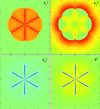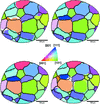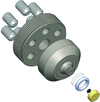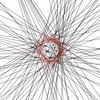issue contents
February 2021 issue

Cover illustration: Procedures improving the effectiveness of automatic ab initio indexing of Laue diffraction patterns [Morawiec (2021). J. Appl. Cryst. 54, 333–337], illustrated with a pattern first published by Ravelli et al. [J. Appl. Cryst. (1996), 29, 270–278].
scientific commentaries
Open  access
access
 access
accessA recent article by Von Dreele, Clarke & Walsh [J. Appl. Cryst. (2021), 54, https://doi.org/10.1107/S1600576720014624] introduces an entirely new paradigm in structure determination, where a complete structural measurement is made in a tenth of a nanosecond.
research papers
The powder diffraction peak shape for a pink X-ray beam is described and applied to Rietveld refinement.
Open  access
access
 access
accessAn overview of a unique life science facility at the European XFEL is provided, and its importance in sample preparation, characterization and analysis prior to measurements at the different European XFEL instruments is discussed. The capabilities that the facility can provide for the research community are highlighted, alongside examples of recent successful studies.
Open  access
access
 access
accessTwo data evaluation concepts are proposed for nondestructive and depth-resolved X-ray residual stress analysis by means of energy-dispersive diffraction on materials featuring cubic symmetry and a nearly single crystalline structure.
Open  access
access
 access
accessEnergy-dispersive diffraction is used for the nondestructive analysis of the hoop stress depth distribution at the inner surface of narrow boreholes. The results are corrected for the rotation effect, which is shown to have a significant influence on the measurements.
In situ energy-dispersive X-ray diffraction was used to track the local formation and conversion of copper oxide phases during solvothermal synthesis. Multi-valence Cu4O3 was found to be resistant to chemical conversion once solvothermally precipitated.
Open  access
access
 access
accessFe–Mn–Al–Ni martensite distortion gives rise to complex backscattered Kikuchi diffraction patterns which cannot be interpreted by standard procedures. Analysis of these patterns reveals that they arise from nanoscale internal twinning and tetragonal distortion of the basically cubic close-packed martensite.
V-pit defects in InGaN/GaN were studied by numerical simulations of the strain field and X-ray diffraction (XRD) reciprocal space maps. The results were compared with XRD and scanning electron microscopy (SEM) experimental data. Creation of the V-pits appears to be a sufficient mechanism for strain relaxation in InGaN/GaN epilayers.
Open  access
access
 access
accessNear-surface polymer dynamics are investigated with grazing-incidence neutron scattering and BornAgain virtual experiments.
Open  access
access
 access
accessThis article reports on energy-dispersive micro Laue (µLaue) diffraction of an individual gold nanowire that was mechanically deformed in three-point bending geometry using an atomic force microscope. The nanowire deformation was investigated by scanning the focused polychromatic X-ray beam along the nanowire and recording µLaue diffraction patterns using an energy-sensitive pnCCD detector that permits measurement of the angular positions of the Laue spots and the energies of the diffracted X-rays simultaneously.
An advanced in-plane grazing-incidence experiment to measure the in-plane reflections at different probing depths is applied to Cu thin films with different thicknesses (ranging between 20 and 300 nm) to assess the strain/stress gradient in thin films. An innovative and robust procedure (including inverse Laplace transform) to derive the depth profile of the in-plane lattice parameter in nanometre-thick films is proposed.
Open  access
access
 access
accessA parameter study of laboratory X-ray diffraction contrast tomography (LabDCT) has been performed to clarify the effects of various experimental parameters on the 3D reconstruction of the grain structure. Recommendations for optimizing LabDCT experiments are given.
The paper describes the implementation of a user-friendly high-pressure small-angle X-ray scattering cell suitable for biological solutions and soft materials.
A method for geometrical analysis of Kossel and Kikuchi line patterns is presented that is suitable for determination of the unknown lattice, its orientation and the indices of the lines simultaneously with extraction of the precise experimental geometry.
Open  access
access
 access
accessA new automatic sample changer based around a novel sample holder is presented for handling microlitre-sized sample drops.
This article reports a systemic investigation of the relation between crystal growth rates and relaxation times of griseofulvin in the bulk and at the free surface. Both the crystal growth rates exhibit a fragility-dependent decoupling from relaxation time.
Open  access
access
 access
accessGrain size distribution and orientation distribution functions are combined in a single multivariate continuous grain size orientation distribution function (GSODF). Several examples of practical applications to low carbon steels are presented, in which it is shown how the GSODF can be used in the analysis of 2D and 3D electron backscatter diffraction data, and as input in full-field and mean-field crystal plasticity simulations.
The grown-in dislocations in protein single crystals are characterized using reconstructed topographic images taken by digital X-ray topography.
Open  access
access
 access
accessAn approach to restore the structural parameters of lipid mixtures from small-angle X-ray scattering data is developed.
X-ray diffraction on acoustically modulated crystals under conditions of either total external reflection or Bragg diffraction is investigated. The dependence of the diffraction process on the X-ray energy is shown.
Open  access
access
 access
accessSimulations of a foil-based spin-echo small-angle neutron scattering instrument are performed and agree with analytical calculations. The simulation tools for polarization manipulation can be used to optimally design new spin-echo instruments.
Open  access
access
 access
accessThis X-ray diffraction study proves that two α polymorphs of copper pthalocyanine (CuPc) co-exist in vacuum-deposited thin films and provides possible molecular configurations by excluded-volume considerations. Furthermore, atomic force microscopy images together with a simple MATLAB simulation show that elevated substrate temperatures facilitate the downward diffusion of CuPc molecules during film growth and lead to a smoother surface.
The existence of one-dimensional ledges on incoherent interphase boundaries has been verified. The interphase boundaries with one-dimensional ledges migrate as a result of the nucleation and extension of the one-dimensional ledge, while the interphase boundaries without one-dimensional ledges migrate according to a continuous mechanism.
Open  access
access
 access
accessA method to robustly determine paracrystalline contents from Rietveld-refined powder X-ray data is presented and discussed for the example of mixed-tacticity polyhydroxybutyrates.
Open  access
access
 access
accessA procedure is outlined for the neutron diffraction determination of residual stress in additively manufactured lattice structures.
Download citation


Download citation


Two novel compounds, K2Cu3(SO4)4 and KNaCu(SO4)2, were synthesized. The BVEL (bond-valence energy landscape) approach has been demonstrated to be a useful method for the prediction of the mobility of alkali metal ions in various structures. The modelling of ion migration maps by the analysis of the procrystal electron-density distribution was used to rapidly identify ion migration pathways and limiting barriers between particular crystallographic sites in the structures under consideration. Its consistency and complementarity with the BVEL method have been demonstrated.
Open  access
access
 access
accessThe fit of the smectite structural formula is reviewed. In addition, a group of samples, both dioctahedral and trioctahedral, are studied, demonstrating the influence of interlaminar Mg that can lead to the erroneous classification of smectite if it is not considered.
Open  access
access
 access
accessThe incident detector rates that are anticipated for the indirect-geometry cold-neutron spectrometer BIFROST at the European Spallation Source are estimated, and the use of powerful simulation tools for the correct interpretation of neutron transport in crystalline materials is demonstrated.
Open  access
access
 access
accessThe dislocation microstructure developing during neutron irradiation is determined by X-ray line profile analysis.
Open  access
access
 access
accessThe elastic stiffness coefficients of thiourea are determined from thermal diffuse scattering.
Optimizations and characterization are described for a state-of-the-art laboratory small-angle X-ray scattering instrument equipped with a Ga metal-jet source at Aarhus University.
Open  access
access
 access
accessInformation theory provides an intriguing framework for evaluating the complexity of a crystal structure. This article provides an improvement to the current theory and describes the integration of the updated formulas into an open-source Python-based program called crystIT.
teaching and education
Open  access
access
 access
accessThis article provides a detailed and visual presentation of the derivations of and relationships between many of the commonly employed functional forms of real- and reciprocal-space data employed by the worldwide total scattering community.
short communications
Procedures improving the effectiveness of automatic ab initio indexing of Laue diffraction patterns are described.
The modification of Hall symbols to describe magnetic space groups is reported.
computer programs
Open  access
access
 access
accessATSAS is a comprehensive software suite for the processing, visualization, analysis and modelling of small-angle scattering data. This article describes developments in the ATSAS 3.0 release, including new programs for data simulation and for the structural modelling of lipids, nucleic acids and polydisperse systems.
This article introduces and describes PyCrystalField, software for crystal electric field calculations. It allows both point charge model calculations and fitting to experimental data.
A self-consistent slab model for small-angle scattering data interpretation of bilayer structures has been implemented within the SasView software suite, and its application to the example of a lipid bilayer is demonstrated.
laboratory notes
Open  access
access
 access
accessThis work demonstrates a sample environment suitable for studying solid–gas interactions by temperature control through thermal contact with a sample in a glass capillary, for temperature and pressure conditions of 0–100 bar (1 bar = 100 kPa) and −30 to 200°C.
Open  access
access
 access
accessA simple and low-cost device has been developed to minimize evaporation in microtiter plates for easy crystal handling and harvesting.
crystallographers
Free 



 journal menu
journal menu




























































